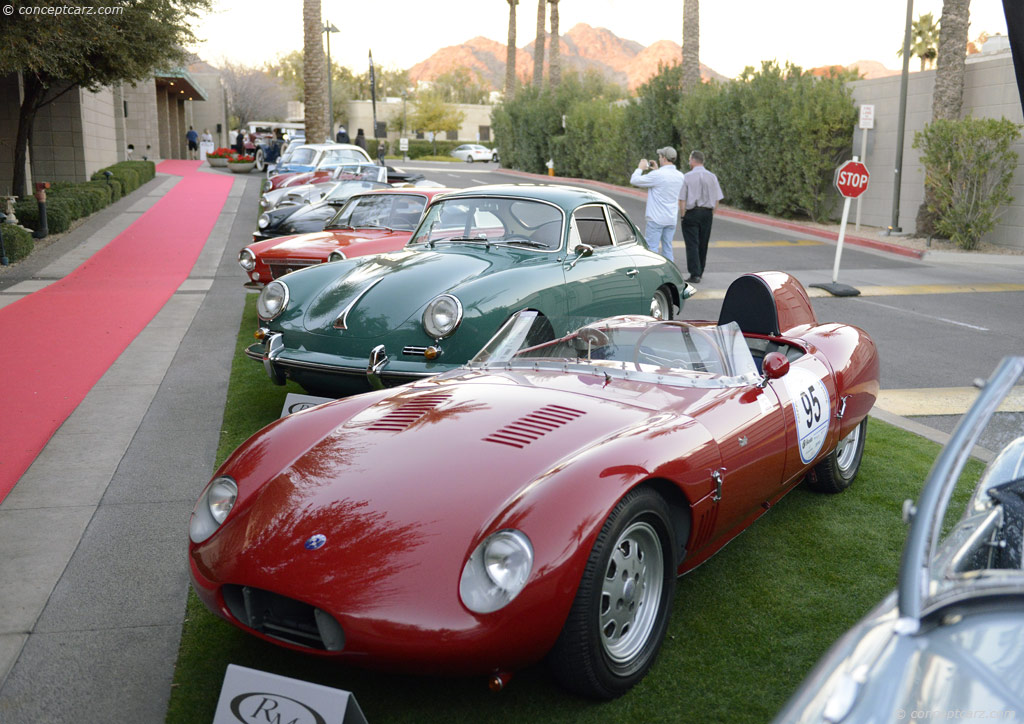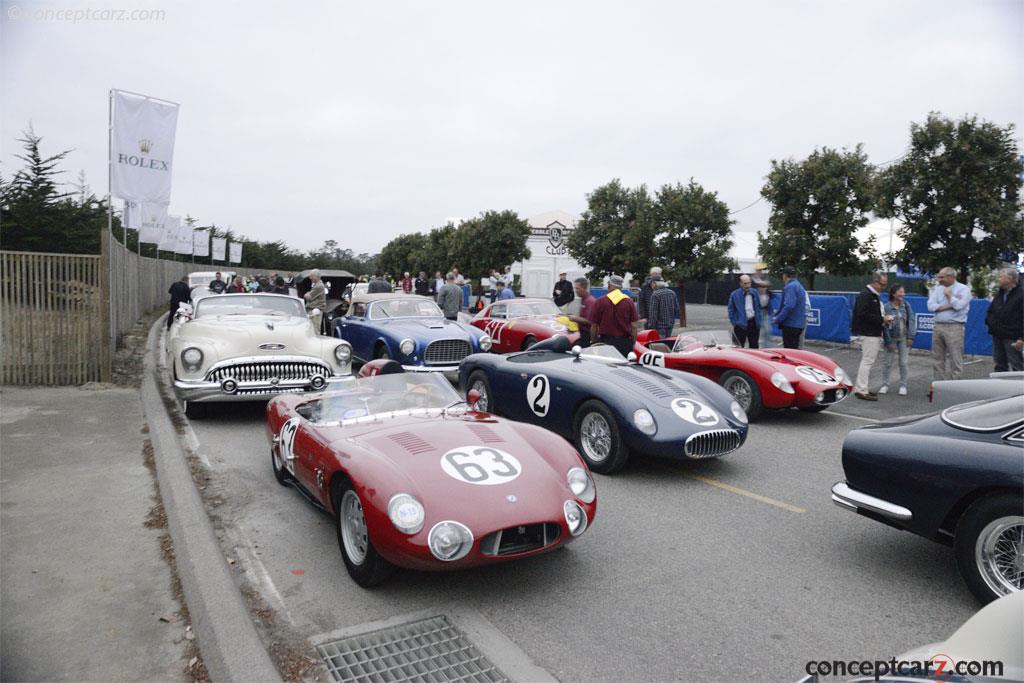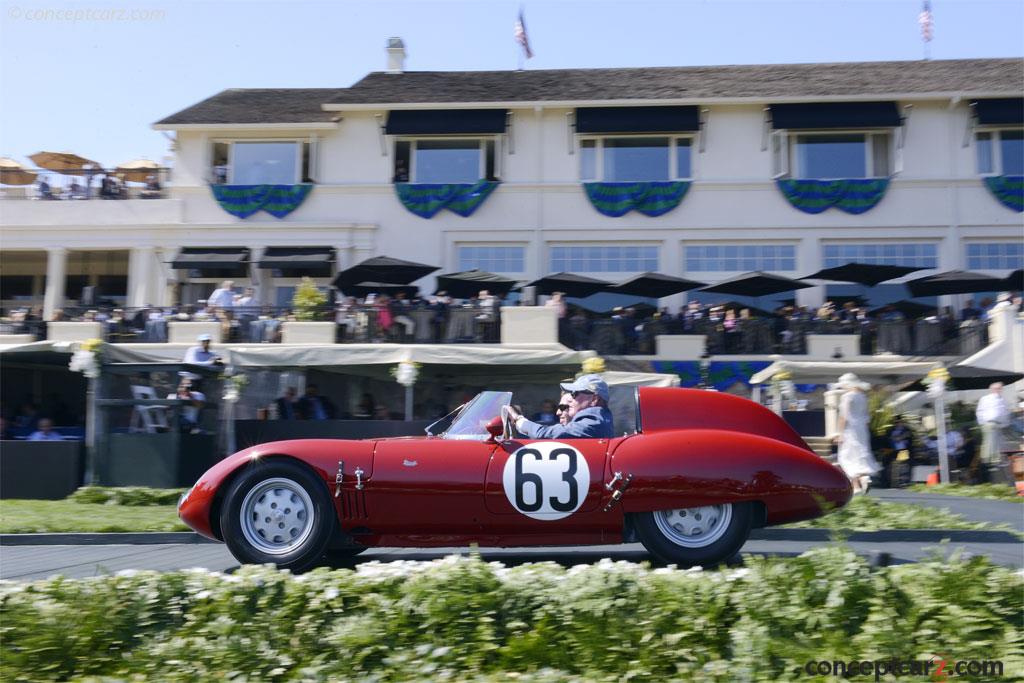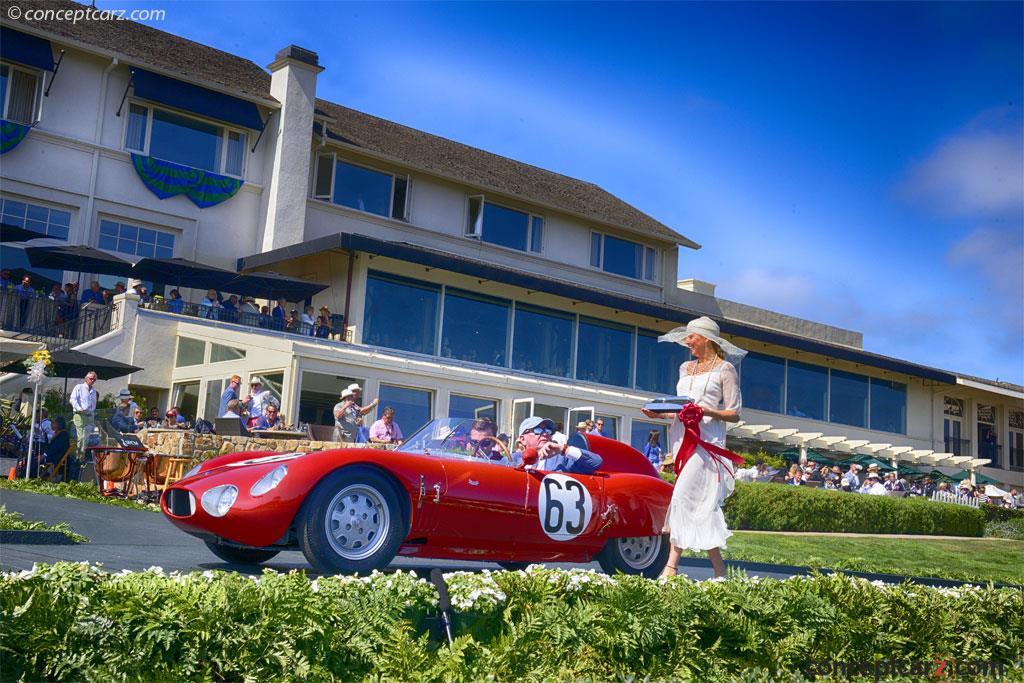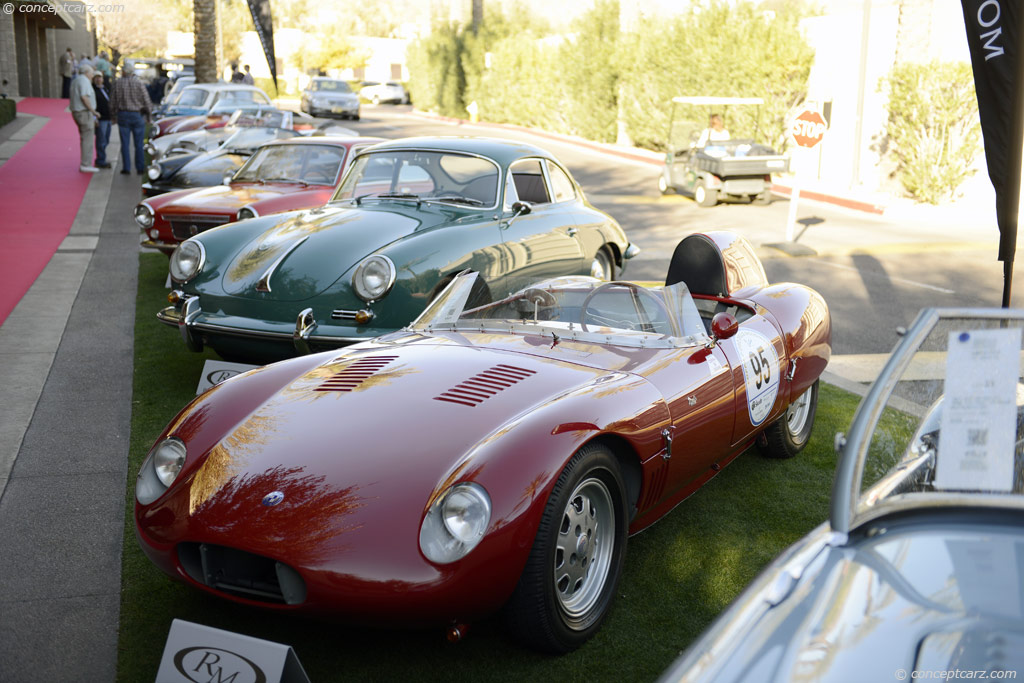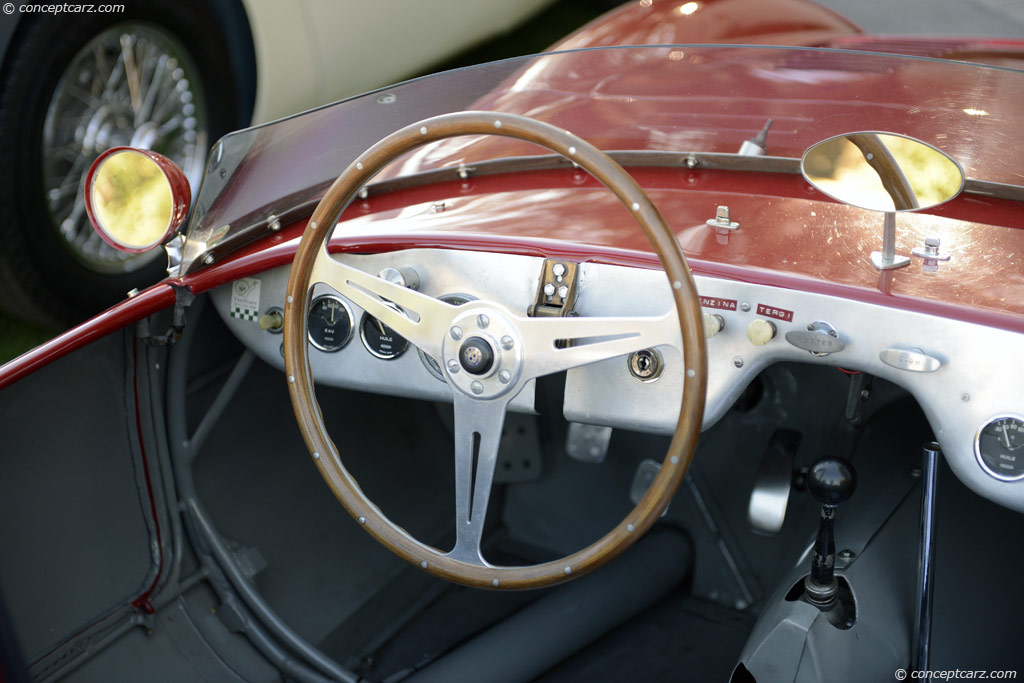Image credit: © conceptcarz.com (Reproduction Or reuse prohibited).
This little OSCA 750 S was known as 'The Giant Killer.' Just 18 OSCA 750 S models were constructed, and all were intended for the 750cc class in endurance racing to compete against the similar Lotus 11s, Fiat-Abarths, and Moretti 750s. The factory first entered a 750 at the 1956 24 Hours of LeMans, and the car continued to race with various successes in Europe and the United States up until 1960.
This car is one of four OSCA 750s with a clamshell body. It was built by the factory for its first owner, John 'Jack' Gordon, and in its first race season, it placed twelfth overall and first in its class at the 1960 Sebring 12 Hours, driven by Gordon and John Bentley. During the next five seasons, the car was raced at Sebring three more times and then at almost all the SCCA race meetings in the Northeast and Midwest, finishing in the top three places in over 80 percent of those races. Later owners included Peter Wessel and Oliver Collins, the latter of which raced it in 25 vintage races. The car was restored in the 1980s, and its current owner bought it in 2014.
This car is one of four OSCA 750s with a clamshell body. It was built by the factory for its first owner, John 'Jack' Gordon, and in its first race season, it placed twelfth overall and first in its class at the 1960 Sebring 12 Hours, driven by Gordon and John Bentley. During the next five seasons, the car was raced at Sebring three more times and then at almost all the SCCA race meetings in the Northeast and Midwest, finishing in the top three places in over 80 percent of those races. Later owners included Peter Wessel and Oliver Collins, the latter of which raced it in 25 vintage races. The car was restored in the 1980s, and its current owner bought it in 2014.
The Maserati brothers were certainly talented designers of automobiles. They would never give up building what they believed to be the best car possible. Unfortunately, none of them would possess the same amount of business acumen as they would engineering talent. And, as often was the case, the brothers would find themselves incapable of producing what was truly rattling around in their heads. Still, they would make do with what they could and the result was often quite surprising.
The Maserati brothers has literally left their name behind and were forced to think about either giving up on their automotive dreams, or, try and start again. Not surprisingly, the brothers would show themselves incapable of admitting defeat and would try and start again forming a new company known as Officine Specializzate Construzione Automobili. Thankfully, for everyone else, they would go by the company's initials—OSCA.
OSCA would come into being in 1947, less than two years after the end of the Second World War. The brothers were eager to try restart and try once again at making a new name for themselves. Based in San Lazzaro di Saveno, very close to the brothers' home in Bologna, OSCA would soon begin construction of its first new designs.
OSCA would be based in the very same place they had built Maseratis prior to the start of the war. So, in many respects, it was a rebirth, a restart, just with a different name. The first to roll out of the factory bearing that new name would be the MT4. This small two-seater barchetta would have a four-cylinder engine capable of producing a little more than 70bhp. As with every other Maserati design, the MT4 would be built with racing in mind, and, in 1948, Luigi Villoresi would pilot one to victory at Pescara and Naples. It was a great start for the company. It seemed as though the brothers had picked up right where they left off.
The company would focus on the smaller classes so as not to over-reach too soon, and this would prove to be a rather successful approach as the company would earn more than a few class victories throughout the 1950s. Of course, one of the biggest victories throughout this era would come in 1954 at the 12 Hours of Sebring.
Stirling Moss and Bill Lloyd would be behind the wheel of an OSCA MT4 and would be faced with serious challenges from Porsche 550s, Jaguar XK120s, Ferrari 375 MMs and Lancia D24s. Still, Lloyd and Moss would come through the 12 hour race in grand style winning the race overall by a margin of some five laps over the S5.0 category Lancia D24 driven by Rubirosa and Valenzano. The tiny OSCA had pulled off a coup proving light and nimble could compete with big and powerful.
OSCA would continue to make small, overreaching, automobiles. Perhaps no other OSCA built better typifies this point than the model introduced in 1956—the 750S.
Prior to the war, the Maserati brothers had been major players in the design of grand prix and endurance sportscars. They would have a hand in the famous 4CL and many others. However, as OSCA, the brothers would go from making bigger, mighty machines to ever-smaller overachieving ones. One of the smallest to be produced, that would also prove quite successful on the track, would be the 750.
The brothers conceived a small engine, just 750 cubic-inches. They needed to design a car around the small engine that wouldn't handicap the power any more than what it already was. They would toss around ideas but would eventually stick with what they knew best. Therefore, the car would be designed with a tube ladder frame chassis. However, the front and rear suspension would depart from the norm in that both would be coil-sprung unlike the semi-elliptic rear suspension that had been a part of every OSCA design prior to that time.
The very backbone of the 750 would be its simplicity, and therefore, reliability. This would help to make the small car one of the most consistent within its class in all history. The small OSCA engine meant there was plenty of room and an ease of maintenance, the perfect combination when it came to sportscar events, especially during the late 1950s and early 1960s.
To drive the 750 was about as close as one came to a Formula One car and that feeling of wearing, or becoming one with, the car. The car already squatted low to the ground and the seats bore out this reality in striking detail. Everything about the car would be neat and tidy and offered a great deal of confidence on those types of tracks where precise handling was of utmost importance.
Because of the car's small size, the steering would feel light and very responsive. In spite of the engines small size, the car offered sprightly acceleration and making the car feel as though it could easily go up against cars with much bigger, more powerful engines. But, in its class, the 750 would be a foe that would be nearly impossible to defeat.
In the United States, the SCCA regulations would have a provision allowing engines of up to 850 cubic inches within the H modified class. OSCA would offer an 850 cc version of its 750 engine in its 750S. It was as if the 750S was purposely-built for the series, and, one of those that would see action with the category would be chassis 769.
John Bentley, who wrote for Sports Car and Road & Track, would finish the 1954 12 Hours of Sebring in 20th place at the wheel of a Siata Fiat. However, he would quickly turn to OSCA and would end up purchasing 769 in 1960.
Bentley would purchase the car not to drive around town, but to go racing. And so, not long after taking delivery of the car he would take it racing. The very first race would be a supreme test of OSCA's reputation for simplicity and reliability. The race would be the 12 Hours of Sebring. Besides cutting out holes for extra headlights in the nose, the OSCA would take part in the race practically as it was delivered. It wouldn't disappoint either as Bentley and Jack Gordon would go on to finish the race 1st in class and 12th overall!
Gordon would end up buying the car from Bentley and would take part in a number of races with the car. The victory in Sebring would end up being just the start of a long and successful career for 769. Gordon would campaign the car successfully for many years. He would claim the northeast title in 1963 and finished 2nd in the championship in 1961, 1962 and again in 1964.
The original engine would be replaced in 1961 with 769N, a spare engine Gordon had ordered from the factory. This spare engine would also be 850 cubic inches in displacement and would be the workhorse Gordon would rely upon for those numerous runner-up performances in the championship.
In 1966, Gordon would sell the car to Roger Clouser of Rochester, New York. The car would make its way around the Altantic coast and Midwest for a couple of decades, and would even undergo a partial restoration. However, in 1983, David DuBrul would purchase the car and would complete the restoration work. The car would be completed in its original state, including the removal of the extra lights in the nose.
Oliver Collins, of Toronto, Canada would purchase the car from DuBrul in 1986 and would use the car in a number of historic races over the next 20 years. Collins would not part with the car until 2005 when it would be sold to its current owner. While appearing in humble fashion, 769 would have reason to be anything but. Not only did the car earn a class victory in Sebring, but it would also set a course record while under Collins' ownership that would stand for nearly a decade.
In the first frame, the 750 is yet another very small OSCA that appears as something of a joke more than a racer to be taken seriously. However, as time has proven, the car was not to be trifled with. On any given day, the car could beat a car of any class and 769 was one of those that had taken bigger cars to task more than once. And, given its record on the track, it would appear the tiny OSCA would take bigger cars to task yet again. The car, well and truly then represented the fighting spirit of the Maserati brothers.
Offered at the 2014 RM Auctions event held in Scottsdale, Arizona, the 1960 OSCA 750 S, chassis number 769 would earn pre-auction estimates ranging from $600,000 and $800,000.
Sources:
Ludvigsen, Karl. 'Tech and Track Report: OSCA 750', (http://www.velocetoday.com/tech-and-track-report-osca-750/). Velocetoday. http://www.velocetoday.com/tech-and-track-report-osca-750/. Retrieved 7 January 2014.
'Sebring 12 Hours', (http://www.racingsportscars.com/results/Sebring-1954-03-07.html). Racing Sports Cars. http://www.racingsportscars.com/results/Sebring-1954-03-07.html. Retrieved 7 January 2014.
'Complete Archive of OSCA S750', (http://www.racingsportscars.com/type/archive/Osca/S750.html?page=3). Racing Sports Cars. http://www.racingsportscars.com/type/archive/Osca/S750.html?page=3. Retrieved 7 January 2014.
Donaldson, Jessica. '1959 OSCA 750 S Type News, Pictures, Specifications and Information', (http://www.conceptcarz.com/vehicle/z8170/Osca-750-S-Type.aspx). Conceptcarz.com: From Concept to Production. http://www.conceptcarz.com/vehicle/z8170/Osca-750-S-Type.aspx. Retrieved 7 January 2014.
'Lot 27: 1960 OSCA 750 S', (http://www.rmauctions.com/lots/lot.cfm?lot_id=1063981). RM Auctions. http://www.rmauctions.com/lots/lot.cfm?lot_id=1063981. Retrieved 7 January 2014.
Wikipedia contributors, 'O.S.C.A.', Wikipedia, The Free Encyclopedia, 7 December 2013, 14:28 UTC, http://en.wikipedia.org/w/index.php?title=O.S.C.A.&oldid=584994619 accessed 7 January 2014
By Jeremy McMullen
The Maserati brothers has literally left their name behind and were forced to think about either giving up on their automotive dreams, or, try and start again. Not surprisingly, the brothers would show themselves incapable of admitting defeat and would try and start again forming a new company known as Officine Specializzate Construzione Automobili. Thankfully, for everyone else, they would go by the company's initials—OSCA.
OSCA would come into being in 1947, less than two years after the end of the Second World War. The brothers were eager to try restart and try once again at making a new name for themselves. Based in San Lazzaro di Saveno, very close to the brothers' home in Bologna, OSCA would soon begin construction of its first new designs.
OSCA would be based in the very same place they had built Maseratis prior to the start of the war. So, in many respects, it was a rebirth, a restart, just with a different name. The first to roll out of the factory bearing that new name would be the MT4. This small two-seater barchetta would have a four-cylinder engine capable of producing a little more than 70bhp. As with every other Maserati design, the MT4 would be built with racing in mind, and, in 1948, Luigi Villoresi would pilot one to victory at Pescara and Naples. It was a great start for the company. It seemed as though the brothers had picked up right where they left off.
The company would focus on the smaller classes so as not to over-reach too soon, and this would prove to be a rather successful approach as the company would earn more than a few class victories throughout the 1950s. Of course, one of the biggest victories throughout this era would come in 1954 at the 12 Hours of Sebring.
Stirling Moss and Bill Lloyd would be behind the wheel of an OSCA MT4 and would be faced with serious challenges from Porsche 550s, Jaguar XK120s, Ferrari 375 MMs and Lancia D24s. Still, Lloyd and Moss would come through the 12 hour race in grand style winning the race overall by a margin of some five laps over the S5.0 category Lancia D24 driven by Rubirosa and Valenzano. The tiny OSCA had pulled off a coup proving light and nimble could compete with big and powerful.
OSCA would continue to make small, overreaching, automobiles. Perhaps no other OSCA built better typifies this point than the model introduced in 1956—the 750S.
Prior to the war, the Maserati brothers had been major players in the design of grand prix and endurance sportscars. They would have a hand in the famous 4CL and many others. However, as OSCA, the brothers would go from making bigger, mighty machines to ever-smaller overachieving ones. One of the smallest to be produced, that would also prove quite successful on the track, would be the 750.
The brothers conceived a small engine, just 750 cubic-inches. They needed to design a car around the small engine that wouldn't handicap the power any more than what it already was. They would toss around ideas but would eventually stick with what they knew best. Therefore, the car would be designed with a tube ladder frame chassis. However, the front and rear suspension would depart from the norm in that both would be coil-sprung unlike the semi-elliptic rear suspension that had been a part of every OSCA design prior to that time.
The very backbone of the 750 would be its simplicity, and therefore, reliability. This would help to make the small car one of the most consistent within its class in all history. The small OSCA engine meant there was plenty of room and an ease of maintenance, the perfect combination when it came to sportscar events, especially during the late 1950s and early 1960s.
To drive the 750 was about as close as one came to a Formula One car and that feeling of wearing, or becoming one with, the car. The car already squatted low to the ground and the seats bore out this reality in striking detail. Everything about the car would be neat and tidy and offered a great deal of confidence on those types of tracks where precise handling was of utmost importance.
Because of the car's small size, the steering would feel light and very responsive. In spite of the engines small size, the car offered sprightly acceleration and making the car feel as though it could easily go up against cars with much bigger, more powerful engines. But, in its class, the 750 would be a foe that would be nearly impossible to defeat.
In the United States, the SCCA regulations would have a provision allowing engines of up to 850 cubic inches within the H modified class. OSCA would offer an 850 cc version of its 750 engine in its 750S. It was as if the 750S was purposely-built for the series, and, one of those that would see action with the category would be chassis 769.
John Bentley, who wrote for Sports Car and Road & Track, would finish the 1954 12 Hours of Sebring in 20th place at the wheel of a Siata Fiat. However, he would quickly turn to OSCA and would end up purchasing 769 in 1960.
Bentley would purchase the car not to drive around town, but to go racing. And so, not long after taking delivery of the car he would take it racing. The very first race would be a supreme test of OSCA's reputation for simplicity and reliability. The race would be the 12 Hours of Sebring. Besides cutting out holes for extra headlights in the nose, the OSCA would take part in the race practically as it was delivered. It wouldn't disappoint either as Bentley and Jack Gordon would go on to finish the race 1st in class and 12th overall!
Gordon would end up buying the car from Bentley and would take part in a number of races with the car. The victory in Sebring would end up being just the start of a long and successful career for 769. Gordon would campaign the car successfully for many years. He would claim the northeast title in 1963 and finished 2nd in the championship in 1961, 1962 and again in 1964.
The original engine would be replaced in 1961 with 769N, a spare engine Gordon had ordered from the factory. This spare engine would also be 850 cubic inches in displacement and would be the workhorse Gordon would rely upon for those numerous runner-up performances in the championship.
In 1966, Gordon would sell the car to Roger Clouser of Rochester, New York. The car would make its way around the Altantic coast and Midwest for a couple of decades, and would even undergo a partial restoration. However, in 1983, David DuBrul would purchase the car and would complete the restoration work. The car would be completed in its original state, including the removal of the extra lights in the nose.
Oliver Collins, of Toronto, Canada would purchase the car from DuBrul in 1986 and would use the car in a number of historic races over the next 20 years. Collins would not part with the car until 2005 when it would be sold to its current owner. While appearing in humble fashion, 769 would have reason to be anything but. Not only did the car earn a class victory in Sebring, but it would also set a course record while under Collins' ownership that would stand for nearly a decade.
In the first frame, the 750 is yet another very small OSCA that appears as something of a joke more than a racer to be taken seriously. However, as time has proven, the car was not to be trifled with. On any given day, the car could beat a car of any class and 769 was one of those that had taken bigger cars to task more than once. And, given its record on the track, it would appear the tiny OSCA would take bigger cars to task yet again. The car, well and truly then represented the fighting spirit of the Maserati brothers.
Offered at the 2014 RM Auctions event held in Scottsdale, Arizona, the 1960 OSCA 750 S, chassis number 769 would earn pre-auction estimates ranging from $600,000 and $800,000.
Sources:
Ludvigsen, Karl. 'Tech and Track Report: OSCA 750', (http://www.velocetoday.com/tech-and-track-report-osca-750/). Velocetoday. http://www.velocetoday.com/tech-and-track-report-osca-750/. Retrieved 7 January 2014.
'Sebring 12 Hours', (http://www.racingsportscars.com/results/Sebring-1954-03-07.html). Racing Sports Cars. http://www.racingsportscars.com/results/Sebring-1954-03-07.html. Retrieved 7 January 2014.
'Complete Archive of OSCA S750', (http://www.racingsportscars.com/type/archive/Osca/S750.html?page=3). Racing Sports Cars. http://www.racingsportscars.com/type/archive/Osca/S750.html?page=3. Retrieved 7 January 2014.
Donaldson, Jessica. '1959 OSCA 750 S Type News, Pictures, Specifications and Information', (http://www.conceptcarz.com/vehicle/z8170/Osca-750-S-Type.aspx). Conceptcarz.com: From Concept to Production. http://www.conceptcarz.com/vehicle/z8170/Osca-750-S-Type.aspx. Retrieved 7 January 2014.
'Lot 27: 1960 OSCA 750 S', (http://www.rmauctions.com/lots/lot.cfm?lot_id=1063981). RM Auctions. http://www.rmauctions.com/lots/lot.cfm?lot_id=1063981. Retrieved 7 January 2014.
Wikipedia contributors, 'O.S.C.A.', Wikipedia, The Free Encyclopedia, 7 December 2013, 14:28 UTC, http://en.wikipedia.org/w/index.php?title=O.S.C.A.&oldid=584994619 accessed 7 January 2014
By Jeremy McMullen
2014 RM Auctions - Automobiles of Arizona
Sale Price :
USD $660,000
Recent Sales of the OSCA 750 S
(Data based on Model Year 1960 sales)
| 1960 OSCA 750 S Chassis#: 769 Sold for USD$660,000 2014 RM Auctions - Automobiles of Arizona |   |
OSCA 750 Ss That Failed To Sell At Auction
1960 OSCA 750 S's that have appeared at auction but did not sell.
| Vehicle | Chassis | Event | High Bid | Est. Low | Est. High |
|---|
Vehicles With Comparable Market Values
Similar sales to the $660,000 range.
| 1984 Audi Sport Quattro Chassis#:WAUZZZ85ZEA905147 Sold for $665,000 2024 RM Sothebys : Arizona |   |
| 1972 FERRARI 365 GTB/4 DAYTONA SPIDER SCAGLIETTI CONVERSION Chassis#:13353 Sold for $660,000 2024 Barrett-Jackson : Scottsdale AZ | |
| 1964 LINCOLN CONTINENTAL CUSTOM CONVERTIBLE Chassis#:4Y86N434680 Sold for $660,000 2024 Barrett-Jackson : Scottsdale AZ | |
| 1971 Plymouth Hemi Cuda Chassis#:bs23r1b227275 Sold for $660,000 2024 Mecum : Kissimmee | |
| 2022 McLaren 765LT Spider Chassis#:SBM14SCA1NW765173 Sold for $665,000 2023 RM Sothebys : Las Vegas | |
| 2021 Mercedes-AMG GT Black Series Project One Edition Chassis#:W1KYJ8BA7MA042580 Sold for $665,000 2023 RM Sothebys : Las Vegas | |
| 1958 CHEVROLET CORVETTE CUSTOM CONVERTIBLE Chassis#:J58S103962 Sold for $660,000 2023 Barrett-Jackson : New Orleans | |
| 1982 Lancia Rally 037 Stradale Chassis#:ZLA151AR000000022 Sold for $654,000 2023 RM Sothebys : Monterey |   |
| 1974 Ferrari 365 GTB/4 Daytona Chassis#:14855 Sold for $660,000 2023 Mecum : Monterey | |
| 1961 Ghia L 6.4 Chassis#:0306 Sold for $665,000 2023 RM Sothebys : Monterey |   |
| 2006 Ford GT Heritage Edition Chassis#:1fafp90sx6y400496 Sold for $660,000 2023 Mecum : Indy | |
| 1967 Chevrolet Corvette Convertible Chassis#:194677s103456 Sold for $660,000 2023 Mecum : Indy | |
| 1931 Cadillac Series 452 V-16 Convertible Coupe Chassis#:702935 Sold for $660,000 2023 Mecum : Indy | |
| 1971 Ferrari 365 GTB/4 Daytona Berlinetta by Scaglietti Chassis#:14207 Sold for $665,000 2023 RM Sothebys : Arizona | |
| 1965 Shelby 427 Cobra Roadster Chassis#:CSX3063 Sold for $660,000 2023 Mecum : Kissimmee | |
| 1932 BENTLEY EIGHT LITRE SPORTS TOURER Chassis#:YM5036 Sold for $655,176 2022 Gooding & Company : London Auction | |
| 1938 Talbot-Lago T150C 'Lago Spéciale' Cabriolet Chassis#:90039 Sold for $665,000 2022 Bonhams : The Quail Auction |   |
| 1994 PORSCHE 964 TURBO-LOOK SPEEDSTER Chassis#:WP0ZZZ96ZRS455486 Sold for $665,000 2022 Gooding & Company : Pebble Beach |  |
| 1996 PORSCHE 993 GT2R Chassis#:WP0ZZZ99ZTS393077 Sold for $665,000 2022 Gooding & Company : Pebble Beach |   |
| 1955 Porsche Type 597 'Jagdwagen' Prototype Chassis#:597/0005 Sold for $665,000 2022 RM Sothebys : Monterey |   |
1960 OSCA 750 S
• Additional valuation insight and sales data• History
• Specifications
• Image gallery
